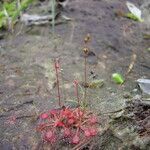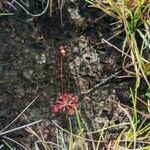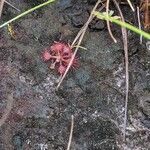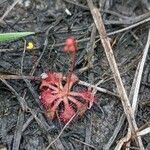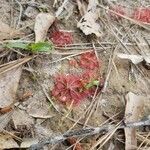Plants not forming winter hibernaculae, rosettes (2–)3–4(–12) cm diam.; stem base not bulbous-cormose. Leaves prostrate; stipules free from or adnate to petioles to 1 mm, then breaking into setaceous segments 3–5 mm; petiole differentiated from blade, 0.6–4 cm, sparsely glandular-pilose; blade broadly spatulate to orbiculate, 0.5–1 cm × 3–5 mm, <usually at least slightly longer than broad, usually shorter than petiole>. Inflorescences 2–20-flowered; scapes 4–20(–35) cm, glabrous. Flowers 10 mm diam.; sepals connate basally, oblong-elliptic, 3–4 × 1–2 mm, <apex obtuse>, glabrous; petals usually pink, sometimes white, obovate, 6–7 × 2–3 mm. Capsules 4–5 mm, <longer than sepals>. Seeds brown, ellipsoid to oblong-ovoid, <asymmetric>, 0.4–0.5 mm, coarsely papillose-corrugated, 14–16-ridged. 2n = 20.
Petioles 0.6–4 cm, sparsely glandular-hairy; lf-blades broadly spatulate, 5–10 × 3–5 mm, usually shorter than the petiole; stipules free, or adnate the first 1 mm, then breaking into numerous setaceous segments 3–5 mm; scape glabrous, 4–20 cm, with 2–20 fls; sep 3–4 mm; pet 6–7 mm, pink, varying to almost white; seeds brown, ellipsoid to oblong-ovoid, 0.4–0.5 mm, asymmetric, coarsely papillose-corrugated in 14–16 ridges; 2n=20. Common in wet low places, chiefly on or near the coastal plain; Va. to Fla. and Tex., and in Tenn.; also in W.I., Mex., and n. S. Amer. May–Aug.
